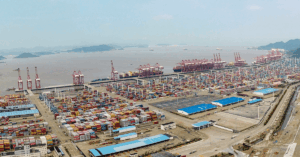
Video: Bulk Carrier Narrowly Escapes Hitting Seawall In St. Clair River
May 29, 2025
Wärtsilä’s 4-Stroke Ammonia Engine Slashes Emissions By Up To 90%
May 29, 2025

The Ningbo-Zhoushan Port in China, known as the busiest port in the world by cargo volume, has launched three new projects with major European ports to help cut emissions from international shipping routes. The European ports involved are Hamburg and Wilhelmshaven in Germany, and Valencia in Spain.
The goal of these projects is to create green shipping corridors-designated sea routes where ships, ports, and other stakeholders work together to reduce greenhouse gas emissions using clean energy, smart systems, and new technologies.
Under these initiatives, the ports will join hands with shipping companies, cargo owners, energy suppliers, researchers, and other players in the supply chain. Together, they aim to adopt zero-carbon technologies, increase the use of clean fuels, and develop smart management practices to decarbonise shipping on selected routes between China and Europe.
Some of the main actions include building and using shore power systems, allowing ships to plug into clean electricity while docked instead of burning fuel, improving freight transport networks, using renewable energy at port facilities, and expanding clean fuel bunkering services such as green methanol or ammonia.
The final goal is to build routes that achieve net-zero carbon emissions from the port of departure all the way to the destination port.
The Ningbo-Zhoushan Port is already a major player in global trade, with more than 300 shipping routes, including over 250 international ones, connecting to over 600 ports in more than 200 countries and regions.
Clean energy has been a major focus for the port. As of now, 74% of its energy consumption comes from renewable sources.
According to Tao Chengbo, chairman of the Ningbo-Zhoushan Port Group, the port will continue to work closely with other ports and shipping companies, especially under the Belt and Road Initiative, to support the global shift toward greener maritime transport.
Green shipping corridors have been growing worldwide. In 2024, there were 62 such initiatives globally, up by 40% compared to the previous year. These corridors involve cooperation between public and private groups to enable zero-emission shipping along specific routes.
While many of these projects are still in early planning or pilot phases, six of them have already progressed to the preparation stage. These include steps like running feasibility studies, preparing roadmaps for implementation, and estimating the costs involved.
Experts say the biggest challenge is what they call the “feasibility wall.” This refers to the financial and operational difficulties of switching to cleaner fuels and systems. One major problem is the lack of strong national policies or financial support to close the cost gap between traditional and green fuel options.
Reference: english.news
Source: Maritime Shipping News


